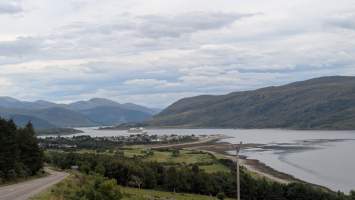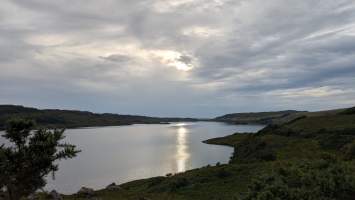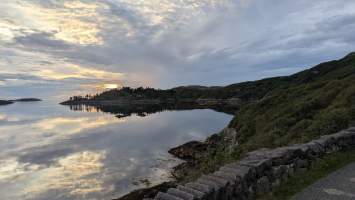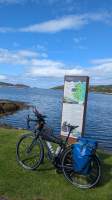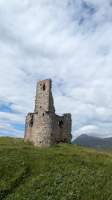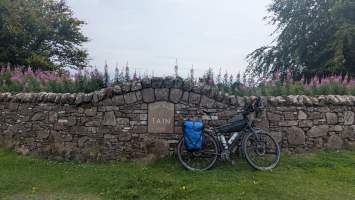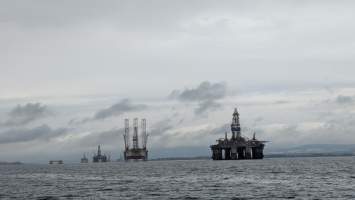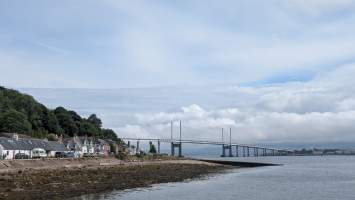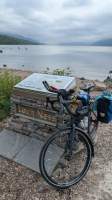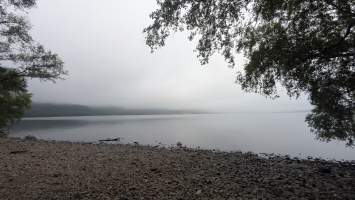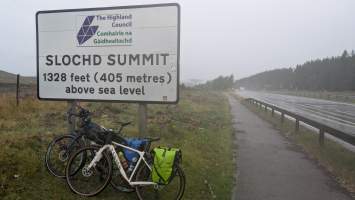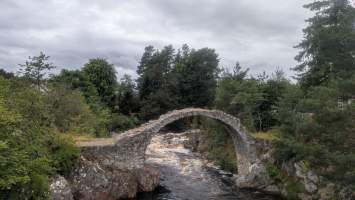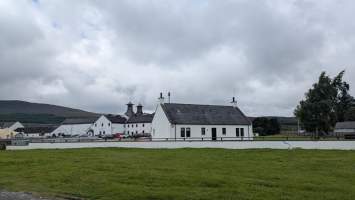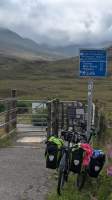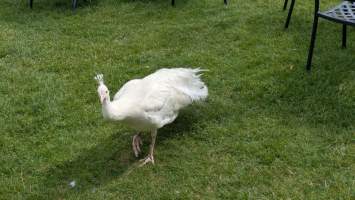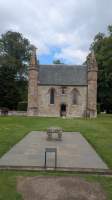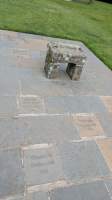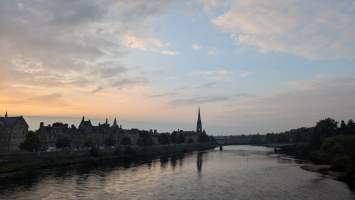West Coast
After ten days on various islands of the Hebrides, Inner and Outer, the mainland accepted us back. In Ullapool, the coastal metropolis with its iconic waterfront and the whitewash painted houses, we stopped for a last meal of fish-n-chips / haggis-n-chips before heading north on the North Coast 500 in search of a pitch for the night.
Little did we know at that point how long it would take us find a decent site to camp. With little to no wind at all -- definitely below the six km/h threshold that keeps the midges at bay -- the road north turned into one long hunting ground for bugs of all kind. Midges, horseflies, mosquitos, blow flies -- all the nasties of the Scottish bogs had ganged up on us. Initially we were confident we'd find a pitch inside the first ten to twenty kilometers, even passing on the campsite just outside Ullapool. Only on Loch Lurgainn we felt the first inkling of a breeze but it had died down when we reached Loch Bad a' Ghaill which had seemed a good candidate for a camping spot. At least we managed to take a short swim in that loch before the bugs could skin us further. Past the lakes on the west coast there was a little more wind, as expected, however the rocky ground and cliffs weren't suitable for camping. In the end we had crossed half of the Coigach peninsula before we found a halfway decent pitch a few kilometers south of Lochinver. That place was on a causeway crossing a bay in the sea, just wide enough to accommodate the tiny tent, but it was quiet and less midge ridden than the interior we just managed to escape.
The next day we had breakfast in Lochinver at the waterfront, saying goodbye to Scotland's west coast. Par for the course on the coastal road, getting to Lochinver required some climbing again, as did the road away from the coast for Loch Assynt. These first two dozen kilometers amounted for more than half of the elevation gain of the day, but past the lake the roads got markedly easier.
Crossing Over
After a visit to the ruins of Ardvreck castle on Loch Assynt we followed the road for the length of the lake and then took the less busy A837 to Lairg. The coastal part of the route was originally only planned as a kind of "stretch goal" in case we'd arrive on the mainland with some extra days left in our schedule. It worked out perfectly as the A837, a typical Scottish single track road with passing places, is the kind of quiet backcountry road that is ideal for bike touring. The scenery it passes through is an absolute treat to the eyes and it is fasciating to observe how vegetation changes with increasing distance to the sea. With its vast pine forests and drawn out, smooth river valleys the contrast to the coast with its steep, hostile rocks is striking.
Thanks to a rare tailwind pushing us on from the west we had an easy ride to Lairg where got a pitch at a campsite near Loch Shin, a large freshwater reservoir. Initially we were excited about the campsite with its idyllic pond and a cozy games shed, but soon changed our minds when it became apparent that it was a paradise for the midges as well.
However we then discovered something worse even than those biting bugs: at some point during the day, most likely a picnic in one of those stunning valleys, we picked up dozens of ticks. The were all over our legs and clothes. And they were all tiny, probably still larvae from one nest we were unfortunate to step in, and thus incredibly hard to spot. Some had already bitten while others were crawling around. We spent the rest of the evening searching every square centimeter of our skin, our clothes, and the tent for these abominations. Let's just hope our quick response is effective against the ungodly diseases ticks tend to spread.
The Black Isle
From Lairg we joined the Eurovelo 12 and let gravity pull us down all the way to the east coast which we met at the Kyle of Sutherland. In the picturesque town of Tain we stopped for lunch. Our sandwiches were under constant threat from a thieving seagull that kept roaming the tables for leftovers. Indeed we were back at the sea.
The Cromarty ferry is a bit elusive. Not operated by Calmac it doesn't have a real schedule or even website, just a note on Facebook, of all, saying there's a sailing each way every twenty to thirty minutes. All in all it seems more like a community effort than a commercial transport service. Not surprising then that the tiny boat would barely fit two cars. There was plenty of space for our bicycles however so we got on board and enjoyed the panorama of retired offshore drilling platforms rusting away in the Cromarty Firth.
On the other side the rain got worse. We cursed the Met Office while we climbed the last hill that stood between us and our destination for the day, the camp site in Fortrose. Another opportunity for me to pitch the tent in "downpour mode", outer hull first on the footprint, adding in the inner layer while shielded from the rain. The rain did not subside during the night, unfortunately.
In the morning we rolled down the peninsula that extends into the Moray Firth from Fortrose to the lighthouse at its tip. Supposedly this is Scotland's prime dolphin spotting site but there weren't any of the creatures hanging out there at low tide so we missed that opportunity.
Inverness and Loch Ness
Approaching Inverness from Kessock one crosses the bridge over the Moray Firth before joining the Ness River at its mouth. Our planned lunch stop at the castle fell through as the hill is closed for reconstruction work so we headed on to Loch Ness. From its northernmost tip the lake looks calm and clear, but not really inviting to swim.
There's better lakes for that in the region! For instance Loch Duntelchaig, located just a few kilometers to the south on a quiet backcounty road through thick forests and patches of heather. By the road we spotted a phenomenal campsite overlooking the south end of the lake. Partly overgrown by trees it sported a pebble beach and some rocks that served as furniture. Midges did not haunt us here despite the lack of wind and rain in the afternoon. It was almost completely quiet there throughout the night apart from a few frogs messing about on the shore.
Cairngorms
After a night of fabulous restful sleep we said goodbye to that near ideal campsite and rolled on towards Tomatin to complete the climb up to Slochd pass en route to the Cairngorms National Park. The night had been dry for a change, but now dark rain clouds were building up on the sky to hit us with a blow of Scotland's finest weather. That blow finally came when we had almost reached the summit; without much of a warning it suddenly started raining cats and dogs. We were only one "mile" away from the coffee shop in Tomatin which we reached completely soaked and stayed for a few hours drinking peppermint tea until the downpour subsided.
Cairngorms
Due to the weather we didn't get to enjoy much of a view of the countryside on the downhill from Slochd summit to Aviemore. The impressive peaks of Ben Macdui, remnants of an ancient volcano crater, had vanished in the thick rain clouds. Occasionally we caught a glimpse of the rocks when those clouds lifted for a moment but the weather remained properly Scottish all afternoon.
We had a rainy night at the Dalraddy campsite where we learned to appreciate the kitchen at the food tent where they serve -- this is not a joke -- original Thuringia bratwurst! Kudos to the master chefs, those sausages were excellent. As was the morning coffee at the coffee van, prepared by a passionate local lady who quit her job in management to enhance the lifes of strangers with outstanding coffee.
After a stop at the gorgeous Dalwhinnie distillery to buy some presents we were ready to tackle the last obstacle that lay still on our route between us and the lowlands: Drumochter pass. I didn't look forward to riding the bike route trailing the A9 again. Last time around I complained about the sorry state of that road but lo and behold, my worries were unfounded: the worst sections of the route have received a new layer of tarmac and there's only a few hundred meters of rubbish surface left these days. Rolling on smooth asfalt were able to enjoy the scenery to the fullest. Despite the summit being the highest point of our itinerary -- and the entire National Cycle Network -- there is nothing difficult about this climb as for the most part it is an endless almost straight, almost flat road that ever so slightly bends to the left while it climbs at sub-1% gradients. On Drumochter, nothing detracts from the panorama of the glen with its tundra peaks and from the vistas of the valleys branching out from it to the west.
Perthshire
At Blair Atholl once more we arrived outside closing hours of the local castle. Not really a loss though, we can do without the posh stuff! The campsite was one of the larger sites we've seen, it impresses with its strict layout following a circular symmetry but at the same time annoyed with the scarcity of power outlets. Also our pitch neighbors were a distinctly different crowd from the outdoorsy types that dominated the campsites up north; the people here camped in large groups with almost Oktoberfest sized tents. Our tiny ultralight tent was almost unnoticable in the vicinity those skyscrapers.
We continued down the Tummel river valley and stopped in Pitlochry to visit the distillery there to buy some of the local spirits -- which somewhat confusingly is Blair Athol branded. I guess the folks to whom it makes sense to get hammered at a rate of 400 GBP per bottle don't overlap much with those that care for geography. Lots of visitors here compared to Dalwhinnie, the sorta picturesque distillery with its ivy walls facing the courtyard must have made it into some East Asian travel guides. When we left the distillery we were carrying almost a liter of whisky in our bike bags, ruining weeks of effort that went into optimizing baggage weight. Sigh.
A Scone of Stone
On the route to Perth we took a detour on the shiny new bridge north of town. It wasn't just the bridge that was new, the area now features some excellent cycling infrastructure including separate two-lane bike paths that don't just end a few meters after a sketchy junction. Impressive, hopefully this is just one sample of future road planning in Scotland!
The detour wasn't just to admire new roads, of course, but to visit Old Scone the coronation site for the Kings of Scotland during the middle ages. A replica of the Stone of Scone is the highlight of the otherwise unimpressive. These days the presumed original is on display in an Edinburgh museum whenever it is not used to imbue the hind parts of some royal with the fairy stuff that magically turns a regular butt into the butt of the king of Scotland.
Usually, when spending a night at a hotel during a bike tour the point is to take a break from the hassles of finding a suitable pitch and setting up camp, and of course to wash as many clothes as possible as thoroughly as possible. When we booked a room in a Perth hotel we expected exactly that: convenience and more time to relax and recover. It wasn't meant to be, however. When we arrived the host casually notified us that there wouldn't be any hot water for an hour and a half. Which is the last thing you want to hear after a day of cycling. Grudgingly we showered with cold water and postponed our laundry plans.
We explored the city center of Perth which appeared half run-down, half quiet with its many closed shops and almost empty streets. The next setback came when we returned to our room: the hot water hadn't been restored as we hoped. Instead, there was no running water at all. The proprietor informed us that "the boiler was bust" and their "engineer" was about to join the water pipes with those of the property next door. The plumbing experiment took a while but eventually we heard the fizzling of water in the system and we finally had both hot and cold water. However our joy didn't last long: the resident above our room must have opened the shower tap before leaving the room empty -- the taps were of a confusing type that didn't really indicate its state -- to the effect that water was dripping from the ceiling into our Ortlieb bags. Instead of clean and dry clothes we now had a soaked tent on top of our other dirty laundry. What a nightmare. We were moved to another room where we could finally complete our self-cleanup, but that night wasn't nearly as refreshing as it should have been.
It is experiences like that make you appreciate the simplicity of wild camping!
